Advertisement
Thoughtful evaluation, time and treatment resolves unusual cause for monocular diplopia
Advertisement
Cleveland Clinic is a non-profit academic medical center. Advertising on our site helps support our mission. We do not endorse non-Cleveland Clinic products or services. Policy
A 55-year-old male presented to Cole Eye Institute complaining of bilateral monocular diplopia and severe photophobia in both eyes. He had undergone uncomplicated cataract surgery, limbal relaxing incisions and Descemet membrane endothelial keratoplasty for Fuchs’ endothelial dystrophy two years prior at another facility.
The patient reported being unable to work for two years as a result of the diplopia, intense photophobia and resulting blepharospasm, and was frustrated that his original eye care provider could not provide a solution. After seeking an opinion from two other consultants without success, he sought a fourth opinion at Cole Eye Institute.
During my initial evaluation, his vision was 20/30 in each eye with no improvement after manifest refraction, and his slit-lamp exam demonstrated rare cells in the anterior chamber of the right eye with mild peaking of the pupil margin superiorly in the right eye and nasally in the left eye. After dilation, a small tag of anterior capsule was noted to be adherent to the posterior iris in the left eye, but no obvious explanation was initially noted for the findings in the right.
The patient was started on a course of topical steroids without resolution. Subsequently, a YAG laser capsulolysis was performed in the left eye, which helped resolve the photophobia in that eye.
After further clinical investigation and ultrasound biomicroscopy (Figure 1), a slightly tilted intraocular lens (IOL) with one haptic in the sulcus was identified in the right eye. The haptic of the single-piece IOL was abutting the iris, creating a uveitis-glaucoma-hyphema syndrome. An IOL exchange in the right eye helped resolve the patient’s photophobia, but he was still experiencing symptoms of monocular diplopia, especially in the right eye. On corneal topography (Figure 2), his corneal curvature revealed a central area of astigmatic steepening (irregular astigmatism), which appeared to be the source of his diplopia.
Advertisement
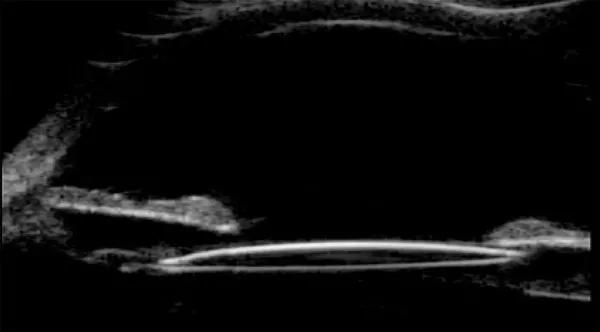
Figure 1. Ultrasound biomicroscopy of the anterior segment of the right eye demonstrating a temporal haptic resting anterior to the anterior capsule with slight lens tilt (partial sulcus placement).
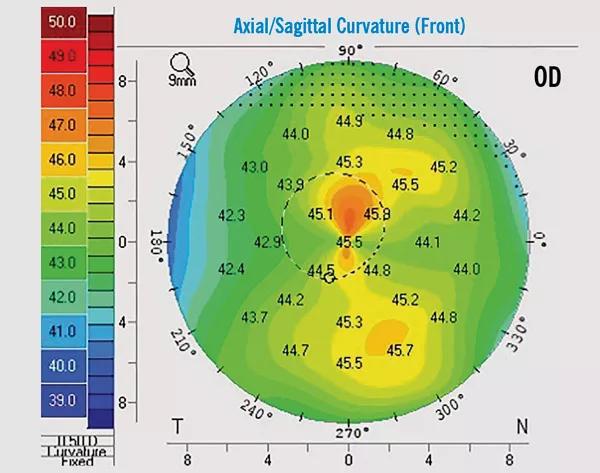
Figure 2. Corneal topography of the right eye demonstrating irregular with-the-rule astigmatism and central steepening, leading to symptoms of monocular diplopia.It was suggested that the likely source of this asymmetric shape was two years of severe photophobia-induced blepharospasm, which compressed the limbal relaxing incisions and buckled the central cornea. The patient was referred for botulinum toxin injections to help alleviate the blepharospasm, which had already begun to improve after the photophobia was corrected.
In addressing the monocular diplopia in his worse (right) eye, I decided to perform a topography-guided customized photorefractive keratectomy (PRK). Since the patient’s best manifest refraction revealed mixed astigmatism with -1.00 +2.00 x 82 (20/20), I attempted an aberration-only correction with partial astigmatism (plano -1.25 x 170), using an asphericity of -0.6 to avoid a hyperopic endpoint (Figure 3).
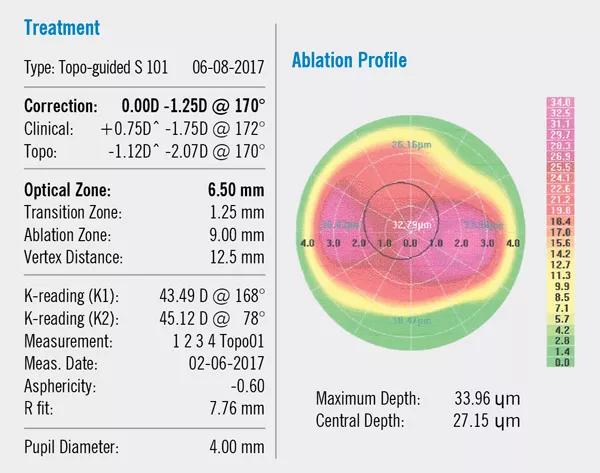
Figure 3. Topography-guided ablation planning and profile of the right eye, demonstrating aberration and partial astigmatism correction with a planned asphericity of -0.6 to help minimize an undesirable hyperopic shift postoperatively.
Postoperatively, the patient reported a significant decrease in the monocular diplopia, and his vision tested at 20/20-2 with a residual manifest refraction of +0.50 +0.25 x 137, resulting in 20/15-1 vision. His postoperative topography showed a reduction in astigmatism with less central steepening, and the difference map revealed up to +2.32 D of flattening with -0.94 D of adjacent steepening within the central 1-2 mm zone (Figure 4).
Advertisement
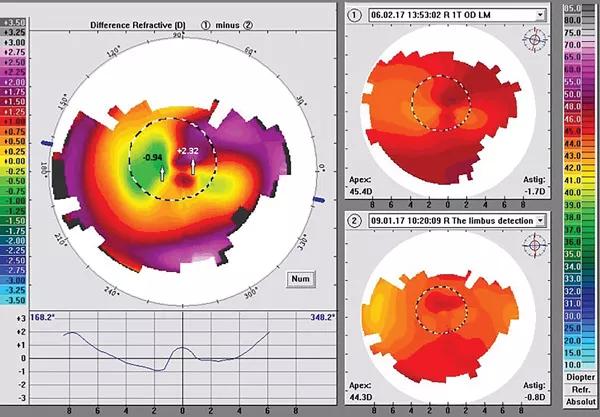
Figure 4. Corneal topography of the right eye, preoperative (upper right), three months postoperative (lower right) and difference map (left) following topography-guided PRK. The central steepening preoperatively is much improved after surgery, with cylinder reduction from 1.7 to 0.8 D. The difference map reveals up to +2.32 D of flattening adjacent to -0.94 D of steepening within the central 1-2 mm zone.
With our success in reducing monocular diplopia in his right eye, the patient decided to schedule topography-guided PRK to resolve any remaining monocular diplopia in the left eye. This has since been completed, and the patient is now 20/15 uncorrected in that eye.
This case represents a unique example of how multiple subjective symptoms without explanation can be caused by multiple objective but interrelated sources. In seeking a real and legitimate diagnosis, rather than dismissing his symptoms as psychologically contrived, we were able to solve a long-standing problem that impacted the patient’s life and livelihood.
The double trouble of his disabling lens/iris-based photophobia with blepharospasm, leading to corneal buckling and his monocular diplopia, required thoughtful evaluation, time and multiple treatments for symptomatic relief.
Dr. Krueger is Director of Refractive Surgery.
Advertisement
Advertisement

Tissue remnants seem unrelated to clinical outcome

A new online calculator can determine probability of melanoma

Flaps, blebs and other surgical options

Therapies include steroid implants, immunomodulation and biologics

A primer on sustained release options
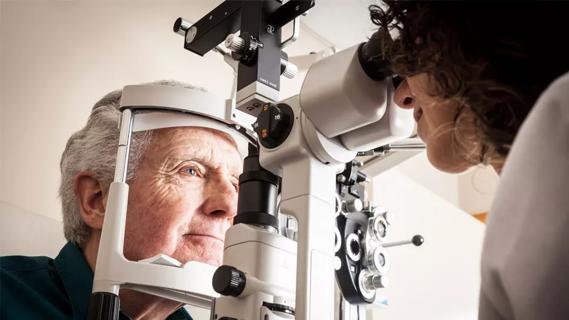
Study explores association between sleep aid and eye disease

Skin conditions could indicate risk of complication after surgery for retinal detachment

New study counters earlier findings linking drugs with eye disease